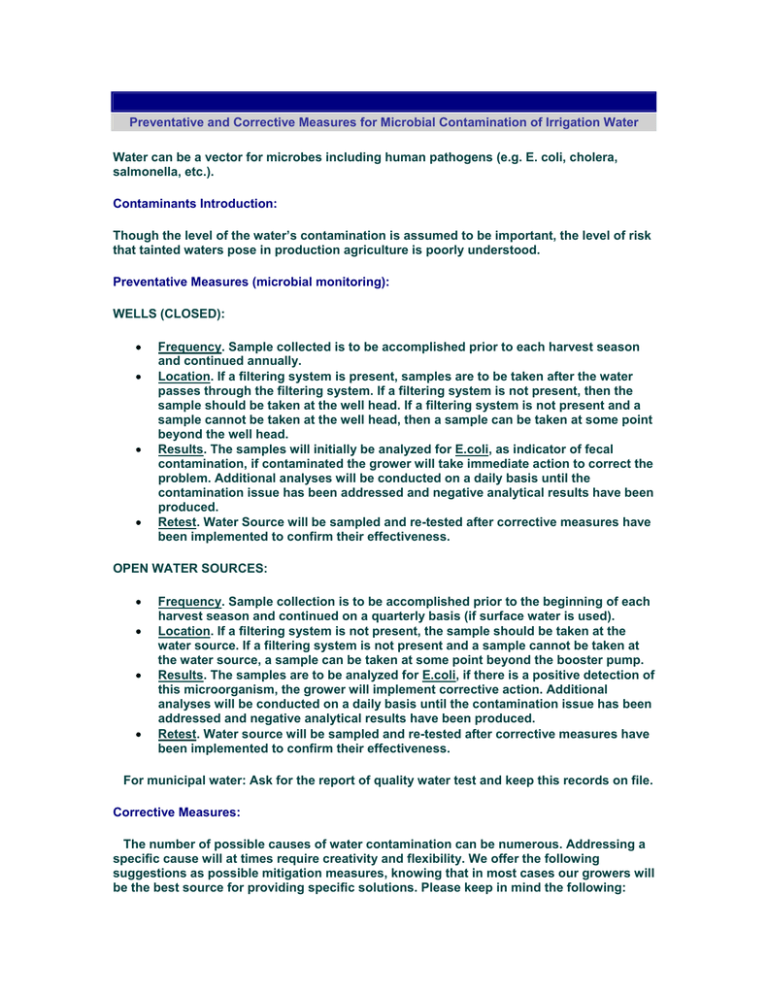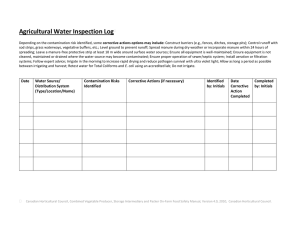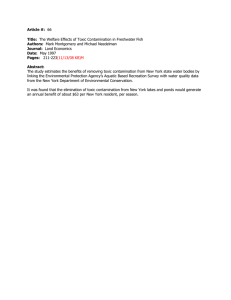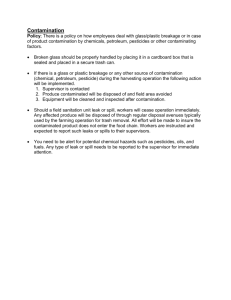Preventative and Corrective Measures for
advertisement

Preventative and Corrective Measures for Microbial Contamination of Irrigation Water Water can be a vector for microbes including human pathogens (e.g. E. coli, cholera, salmonella, etc.). Contaminants Introduction: Though the level of the water’s contamination is assumed to be important, the level of risk that tainted waters pose in production agriculture is poorly understood. Preventative Measures (microbial monitoring): WELLS (CLOSED): • • • • Frequency. Sample collected is to be accomplished prior to each harvest season and continued annually. Location. If a filtering system is present, samples are to be taken after the water passes through the filtering system. If a filtering system is not present, then the sample should be taken at the well head. If a filtering system is not present and a sample cannot be taken at the well head, then a sample can be taken at some point beyond the well head. Results. The samples will initially be analyzed for E.coli, as indicator of fecal contamination, if contaminated the grower will take immediate action to correct the problem. Additional analyses will be conducted on a daily basis until the contamination issue has been addressed and negative analytical results have been produced. Retest. Water Source will be sampled and re-tested after corrective measures have been implemented to confirm their effectiveness. OPEN WATER SOURCES: • • • • Frequency. Sample collection is to be accomplished prior to the beginning of each harvest season and continued on a quarterly basis (if surface water is used). Location. If a filtering system is not present, the sample should be taken at the water source. If a filtering system is not present and a sample cannot be taken at the water source, a sample can be taken at some point beyond the booster pump. Results. The samples are to be analyzed for E.coli, if there is a positive detection of this microorganism, the grower will implement corrective action. Additional analyses will be conducted on a daily basis until the contamination issue has been addressed and negative analytical results have been produced. Retest. Water source will be sampled and re-tested after corrective measures have been implemented to confirm their effectiveness. For municipal water: Ask for the report of quality water test and keep this records on file. Corrective Measures: The number of possible causes of water contamination can be numerous. Addressing a specific cause will at times require creativity and flexibility. We offer the following suggestions as possible mitigation measures, knowing that in most cases our growers will be the best source for providing specific solutions. Please keep in mind the following: corrective measures must be effective, provide on going prevention and confirmed as efficacious. a. For a well tainted by a microorganism, where the cause of contamination results from a single isolated atypical or non-repetitive event (i.e. flooding,) a possible corrective measure would be “shocking” the well with chlorine*. b. If a breach in the well’s casing has resulted in the well being more susceptible to contamination then the casing should be repaired or an alternative water source should be found. c. If the water source can not be treated and is suspected or confirmed to be contaminated an alternative (i.e. different well, etc.) should be used. d. For water sources that are contaminated and where alternative water supplies are not available an automatic chlorination system is a possible mitigation measure. * In the United States chlorine is commonly the material of choice for treating waters to kill or eliminate many microbes. Some microbes in certain stages of development are not impacted by chlorine (i.e. Cryptosporidium, etc.). Strictly adhere to the restrictions and guidelines specified on the label.



